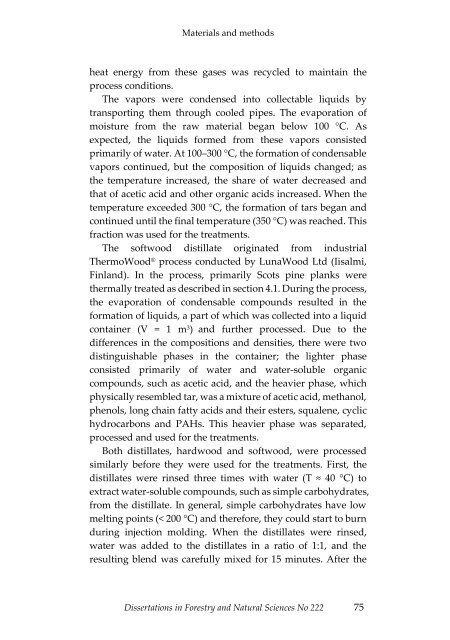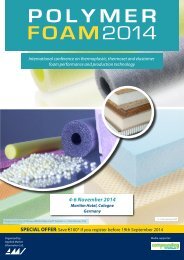Dissertations in Forestry and Natural Sciences
24lYKFN
24lYKFN
Create successful ePaper yourself
Turn your PDF publications into a flip-book with our unique Google optimized e-Paper software.
Materials <strong>and</strong> methods<br />
heat energy from these gases was recycled to ma<strong>in</strong>ta<strong>in</strong> the<br />
process conditions.<br />
The vapors were condensed <strong>in</strong>to collectable liquids by<br />
transport<strong>in</strong>g them through cooled pipes. The evaporation of<br />
moisture from the raw material began below 100 °C. As<br />
expected, the liquids formed from these vapors consisted<br />
primarily of water. At 100–300 °C, the formation of condensable<br />
vapors cont<strong>in</strong>ued, but the composition of liquids changed; as<br />
the temperature <strong>in</strong>creased, the share of water decreased <strong>and</strong><br />
that of acetic acid <strong>and</strong> other organic acids <strong>in</strong>creased. When the<br />
temperature exceeded 300 °C, the formation of tars began <strong>and</strong><br />
cont<strong>in</strong>ued until the f<strong>in</strong>al temperature (350 °C) was reached. This<br />
fraction was used for the treatments.<br />
The softwood distillate orig<strong>in</strong>ated from <strong>in</strong>dustrial<br />
ThermoWood ® process conducted by LunaWood Ltd (Iisalmi,<br />
F<strong>in</strong>l<strong>and</strong>). In the process, primarily Scots p<strong>in</strong>e planks were<br />
thermally treated as described <strong>in</strong> section 4.1. Dur<strong>in</strong>g the process,<br />
the evaporation of condensable compounds resulted <strong>in</strong> the<br />
formation of liquids, a part of which was collected <strong>in</strong>to a liquid<br />
conta<strong>in</strong>er (V = 1 m 3 ) <strong>and</strong> further processed. Due to the<br />
differences <strong>in</strong> the compositions <strong>and</strong> densities, there were two<br />
dist<strong>in</strong>guishable phases <strong>in</strong> the conta<strong>in</strong>er; the lighter phase<br />
consisted primarily of water <strong>and</strong> water-soluble organic<br />
compounds, such as acetic acid, <strong>and</strong> the heavier phase, which<br />
physically resembled tar, was a mixture of acetic acid, methanol,<br />
phenols, long cha<strong>in</strong> fatty acids <strong>and</strong> their esters, squalene, cyclic<br />
hydrocarbons <strong>and</strong> PAHs. This heavier phase was separated,<br />
processed <strong>and</strong> used for the treatments.<br />
Both distillates, hardwood <strong>and</strong> softwood, were processed<br />
similarly before they were used for the treatments. First, the<br />
distillates were r<strong>in</strong>sed three times with water (T 40 °C) to<br />
extract water-soluble compounds, such as simple carbohydrates,<br />
from the distillate. In general, simple carbohydrates have low<br />
melt<strong>in</strong>g po<strong>in</strong>ts (< 200 °C) <strong>and</strong> therefore, they could start to burn<br />
dur<strong>in</strong>g <strong>in</strong>jection mold<strong>in</strong>g. When the distillates were r<strong>in</strong>sed,<br />
water was added to the distillates <strong>in</strong> a ratio of 1:1, <strong>and</strong> the<br />
result<strong>in</strong>g blend was carefully mixed for 15 m<strong>in</strong>utes. After the<br />
<strong>Dissertations</strong> <strong>in</strong> <strong>Forestry</strong> <strong>and</strong> <strong>Natural</strong> <strong>Sciences</strong> No 222 75



